I’ll never forget the night I found myself lost in a ruined castle somewhere outside Prague. My phone was dying, rain was seeping through my jacket, and every step echoed twice as loud as it should’ve in the empty courtyard. No tour groups, no friendly docents—just me, the wind, and an uneasy feeling I couldn’t quite shake. If I’m honest, I laughed at myself. Who gets spooked by a lump of old stones? But there it was: the hairs prickling up along my arms, the sense I’d wandered into somebody else’s memory.
That’s the thing about haunted castles in Europe. You think you’re coming for history—knights, kings, romantic views. But what you remember later are the strange details: the smell of wet stone, a window banging shut when no one’s near, the way dusk sneaks up so fast behind those thick walls. It’s never the “official” ghost stories that get under your skin—it’s the questions. Why did I hurry through that corridor? Did I just hear footsteps behind me, or was it just the rain?
I’ve met plenty of skeptics at castle gates. Honestly, I’m not sure where I land on the ghost scale myself. But walk these places after closing, when the last selfie-takers are gone, and tell me you don’t feel something—maybe not a ghost, but the past brushing up against the present. In some castles, it’s a heaviness; in others, an unexpected warmth, as if someone invisible is walking with you, just out of sight.
So here’s what I love: every one of these castles has its own brand of mystery. Some are all gloom and thunder, others almost playful. I’ve stayed up swapping stories with strangers by firelight, listened to caretakers mutter about creaking doors, and once watched a group of kids dare each other to touch the “haunted” suit of armor. Maybe that’s why we keep coming back—not for answers, but for the tingle of wonder that only an old, storied place can offer.
So—if you’re ready to wander where the shadows gather and legends linger, keep your eyes open and your mind wide. The best stories are the ones you stumble into by accident. Shall we begin?

Quick Facts
📍 Region: Europe – Multiple Countries (incl. Romania, Ireland, England, Austria, Slovenia, Czech Republic, Denmark, Scotland, Germany, Northern Ireland, Ukraine, Switzerland, France)
🏰 Castles: Bran Castle, Leap Castle, Chillingham Castle, Moosham Castle, Predjama Castle, Houska Castle, Dragsholm Castle, Edinburgh Castle, Eltz Castle, Burg Frankenstein, Voergaard Castle, Ballygally Castle, Pidhirtsi Castle, Montebello Castle, and Château de Brissac
👻 Notable For: Ghost stories, local legends, tragic love affairs, dark histories, supernatural encounters, and atmospheric night tours
🎟️ Best Ways to Visit: Guided tours, self-guided road trips, evening ghost walks, Halloween events, and organized paranormal investigations
📅 Best Time to Visit: Autumn (especially late September–November), Halloween, early spring, and for night tours or off-peak weekday visits
🌗 Unique Experiences: Night tours by candlelight, sleepovers in haunted rooms, ghost hunting with equipment, historic reenactments, and storytelling by local guides
♿ Accessibility: Varies: Many castles have steep stairs, uneven paths, or limited wheelchair access—always check ahead
💡 Travel Tips: Book ahead for special events, dress in layers, bring sturdy shoes, keep an open mind, and respect site rules and legends
📸 Must-Pack Items: Warm clothing, flashlight, camera, notebook, snacks, and a healthy sense of curiosity

Bran Castle, Romania: The Shadow of Dracula’s Legend

Bran Castle isn’t just famous for its looks—it’s a place where old stories and strange feelings seem to settle in with the mist. Sitting above the narrow valley in Transylvania, this castle’s sharp towers cut through the trees. It’s easy to see why so many ghost tales have taken root here. The castle isn’t just about Dracula, though you’ll hear plenty about him. The setting alone—steep walls, thick woods, fog in the morning—makes an impression that lasts.
Most visitors are drawn in by the Dracula connection. Bram Stoker never visited, but his novel gave Bran’s silhouette a special kind of fame. The truth? Vlad the Impaler probably never lived here, though he may have passed through. Still, you can understand why the myth stuck. Beyond vampires, Bran has its own legends: some visitors talk about the Lady in White, glimpsed late at night along the ramparts. Others report odd sounds from the lower rooms and cellars—quiet knocks, or a cold patch where none should be.
Bran Castle’s story is long and tangled. Built in the late 1300s to guard a mountain pass, it spent centuries as a fortress and border post. Later, it became a royal residence. Queen Marie of Romania tried to bring some comfort and color to the old stone halls, but you can still feel the medieval mood—especially in the narrow stairwells and cramped rooms.
What makes Bran memorable is how it feels once you’re inside. The stones are cold even in summer, the wind whistles through cracks, and you can catch the scent of pine from the forests below. The place seems built for secrets. Many people leave without seeing a ghost, but almost everyone remembers the sense that Bran is never completely empty.
Want the full story behind Bran Castle, including its history, legends, and practical tips? Check out our in-depth Bran Castle Romania Guide for everything you need to plan your visit.
Travel Tips:
- Best Time to Visit: Autumn is best, especially close to Halloween, when the castle hosts special events and night tours. Early morning or late afternoon visits are quieter.
- Tickets & Tours: Buy tickets online or at the entrance. Guided tours are a good way to hear both history and local legends. Check the official website for the latest ticket prices and up-to-date opening hours.
- Accessibility: Expect lots of stairs and some uneven floors. Wear shoes with a good grip.
- Extras: There’s a small museum in the courtyard—worth a look if you want to learn more about Romanian customs and myths.
- Pro Tip: Don’t rush. Let yourself explore at your own speed. Some of the best moments come when you linger in a quiet corner or look out across the forested hills.
- Website: https://www.bran-castle.com
Bran Castle is more than just a backdrop for vampire tales. If you come with a curious mind, you’ll find history and mystery in every shadow.

Leap Castle, Ireland: Where Spirits Never Sleep

Leap Castle doesn’t look especially grand from the road, but don’t be fooled. Tucked into the green heart of County Offaly, this thick-walled fortress is famous across Ireland for its restless energy. If you’ve ever wondered whether old buildings can actually feel haunted, Leap will test your nerves. Some call it the most haunted castle in Europe, and it doesn’t take long inside to see why.
Most people hear about Leap Castle because of its reputation for ghostly encounters. The best-known story is tied to the “Bloody Chapel,” where a brutal family feud ended with murder right at the altar. Visitors have reported seeing a shadowy figure there, or feeling cold spots even in the middle of summer. There’s also talk of the “Elemental,” a strange presence said to bring with it a strong sense of dread, and sometimes a foul smell. Other legends tell of lost souls trapped in the dungeon, or the faint sound of chanting from behind thick stone walls.
Leap Castle’s history is tangled and sometimes violent. Built in the 13th century by the O’Carroll clan, it’s seen its share of battles, betrayals, and bloody power struggles. Even after the worst of the feuds, the castle continued to be passed down and restored by new owners. Today, it’s still privately owned and lived in, which only adds to its peculiar, lived-in feel.
What makes Leap stand out isn’t just the stories—it’s the mood of the place itself. The air inside is heavy. Every stair creaks. Even on a bright afternoon, the rooms feel dim and close, with sunlight struggling through arrow-slit windows. It’s a place that invites quiet, careful exploration. Whether you see a ghost or not, you’ll remember the way Leap makes you feel.
Travel Tips:
- Best Time to Visit: Leap Castle is open to visitors by appointment. Autumn and winter add to the eerie atmosphere, but any rainy Irish day will do.
- Tickets & Tours: Visits must be arranged in advance—check the official website or call ahead. Often, you’ll be shown around by the owner, who has his own tales to tell.
- Accessibility: The castle is historic, so expect steep stairs and uneven floors. Wear sturdy shoes.
- Extras: If you’re lucky, you might hear live traditional music in the main hall.
- Pro Tip: Bring an open mind and a camera, but don’t expect polished museum-style displays. Leap is all about the raw experience.
- Website: https://leapcastle.net
Leap Castle is less about flashy history and more about atmosphere. If you want to feel the weight of old stories pressing close, few places deliver like this one.

Chillingham Castle, England: England’s Most Haunted Stronghold
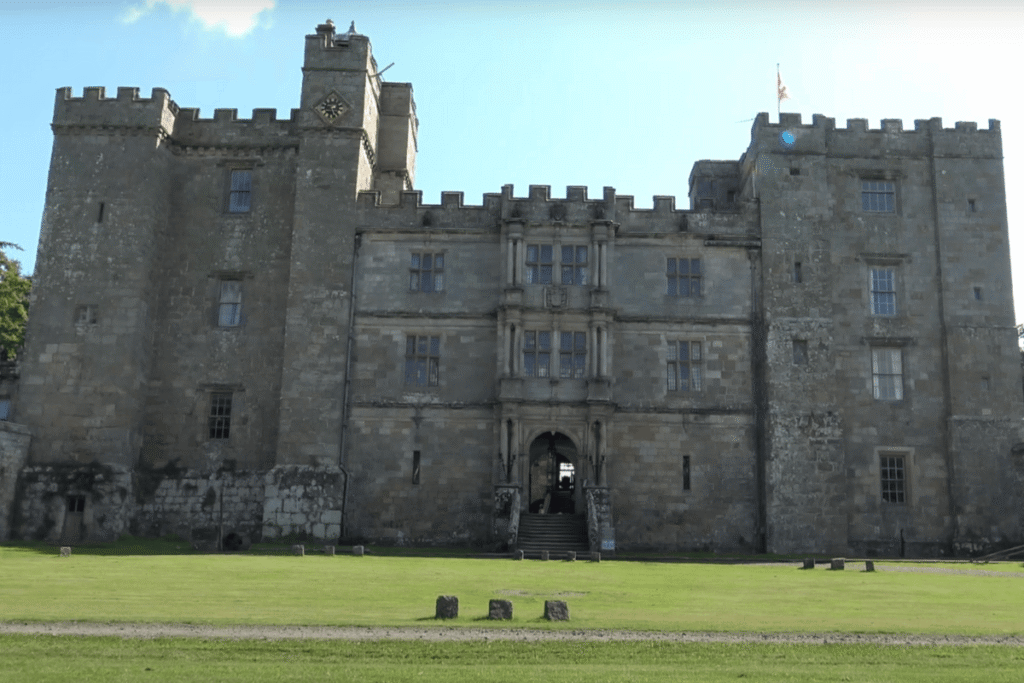
If you want to see what a real haunted castle feels like, Chillingham in Northumberland is the place. The building is old and worn, with thick grey walls that seem to press in as soon as you step through the door. This isn’t a castle that hides its age or its past. It’s famous for a reason—stories have been building here for centuries, and the air inside almost seems to remember them all.
Many people visit Chillingham for the ghost stories. The Blue Boy is the most talked about; guests in the Pink Room sometimes say they see blue flashes of light or hear a child crying from inside the walls. The story goes that bones and scraps of blue cloth were found bricked up years ago. Other ghosts include the White Pantry Ghost and the spirit of John Sage, once the castle’s torturer. People talk about sudden cold spots, strange shadows, and odd noises in empty rooms. Even if you’re not a believer, it’s hard to ignore the odd feeling you get when you’re alone here.
Chillingham Castle’s history is rough and full of real events. Built in the 1200s, it sat on the frontline of battles between England and Scotland. Armies came and went, and the castle changed hands many times. Old scars and stories are everywhere—arrow marks in the stone, worn stairs, and old prison cells. The place has been partly restored, but much of it still feels wild and untouched.
What makes Chillingham stand out isn’t just the stories, but how the place feels, especially when it’s quiet. Sunlight comes in thin, and the air is always cool, no matter the season. You’ll notice the floors creak, and some rooms just feel heavy. Some visitors see nothing out of the ordinary, but almost everyone leaves talking about the strange atmosphere.
Travel Tips:
- Best Time to Visit: Go in autumn if you can, especially around Halloween. That’s when there are ghost tours and evening events. Weekday mornings are best for a quieter visit.
- Tickets & Tours: Book tickets online or buy at the door. If you want the full experience, take a guided or ghost tour—guides know all the stories. Check the official website for the latest ticket prices and up-to-date opening hours.
- Accessibility: The castle has uneven floors and tight spiral stairs. Wear sturdy shoes and be ready for some climbing.
- Extras: The gardens and tea room are worth a stop, especially if you need a break from the spooky side.
- Pro Tip: Don’t rush. Stand still in one of the quieter rooms and let yourself soak up the atmosphere. Sometimes the silence tells the best story.
- Website: https://www.chillingham-castle.com
Chillingham isn’t just for ghost hunters. Anyone with an interest in real history and legend will find something to remember here.

Moosham Castle, Austria: The Witches’ Fortress
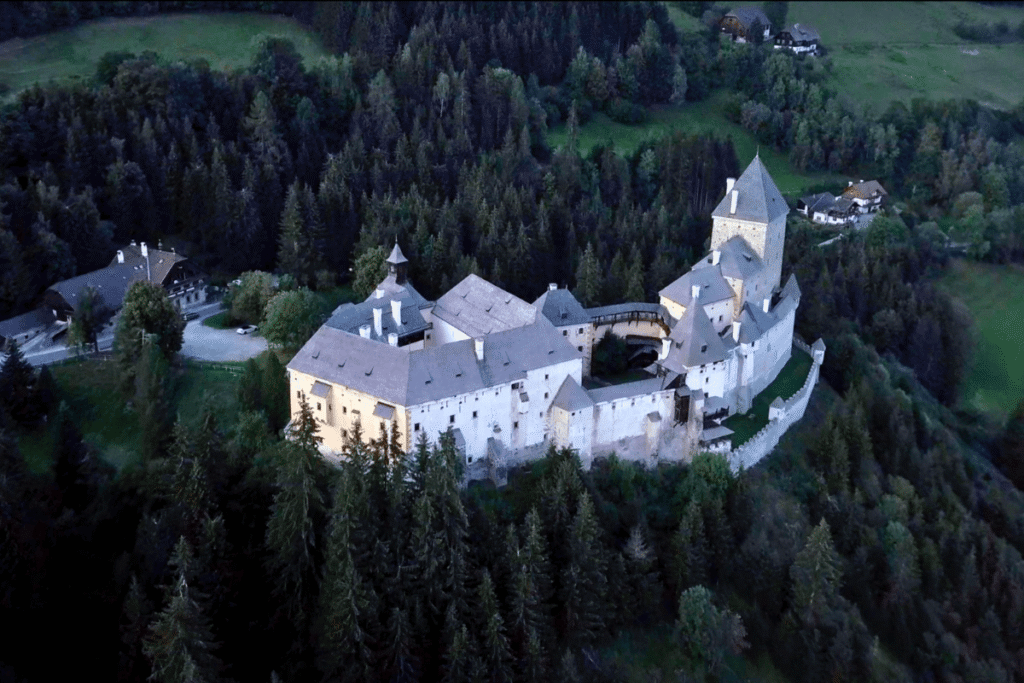
Moosham Castle sits in the remote forests of Salzburg, Austria, surrounded by tall pines and the sound of rushing wind. The castle is strong and imposing, its walls built for defense. Over the years, though, it became known for something darker. Moosham has a reputation as one of the most haunted places in the country, and the stories here are heavier than most.
Most people know Moosham as the “Witches’ Castle.” In the 17th century, this was the center of the Salzburg witch trials. Dozens of people—many of them women—were imprisoned, tortured, and executed inside these walls. Local guides still talk about the cries heard at night, and visitors sometimes mention cold spots, strange movements, or the sense of being watched in the old dungeons. Some even claim to have seen shadows moving where there’s no one around. If you’re interested in true dark history, this castle delivers.
Moosham’s story is long. Built in the 1200s, it changed hands many times, surviving war and periods of abandonment. Its reputation grew during the witch trial era, but its halls also sheltered nobles and hunters over the centuries. Today, the rooms are filled with artifacts from Austria’s past—paintings, hunting trophies, and furniture that feels almost frozen in time.
The atmosphere here is what sets Moosham apart. The forest seems to close in around the castle, and the rooms are quiet and cool, even on hot days. The old stones hold onto the past, and every creak or sudden chill makes you wonder what else these walls have seen. If you come for the ghost stories, you’ll find plenty. If you come for the history, you’ll find even more.
Travel Tips:
- Best Time to Visit: Moosham is open mainly from spring through early autumn. Summer is most convenient, but misty spring and fall days offer the best mood for ghost seekers.
- Tickets & Tours: Buy tickets at the entrance. Guided tours are available and are the best way to learn about the witch trials and castle legends. Check the official website for the most up-to-date ticket prices and schedules.
- Accessibility: There are many steps, uneven paths, and narrow corridors—good shoes are a must, and not all areas are wheelchair accessible.
- Extras: Don’t miss the collection of artifacts and old paintings in the upper rooms.
- Pro Tip: Spend a little time in the dungeons or courtyard after your tour—these are the spots where people most often report unusual experiences.
- Website: https://www.schlossmoosham.at/das-schloss.html
Moosham Castle is not just a place for ghost stories. It’s a real reminder of Europe’s darker past. A visit here will stick with you, whether or not you meet a spirit in the halls.

Predjama Castle, Slovenia: Fortress in the Cliff
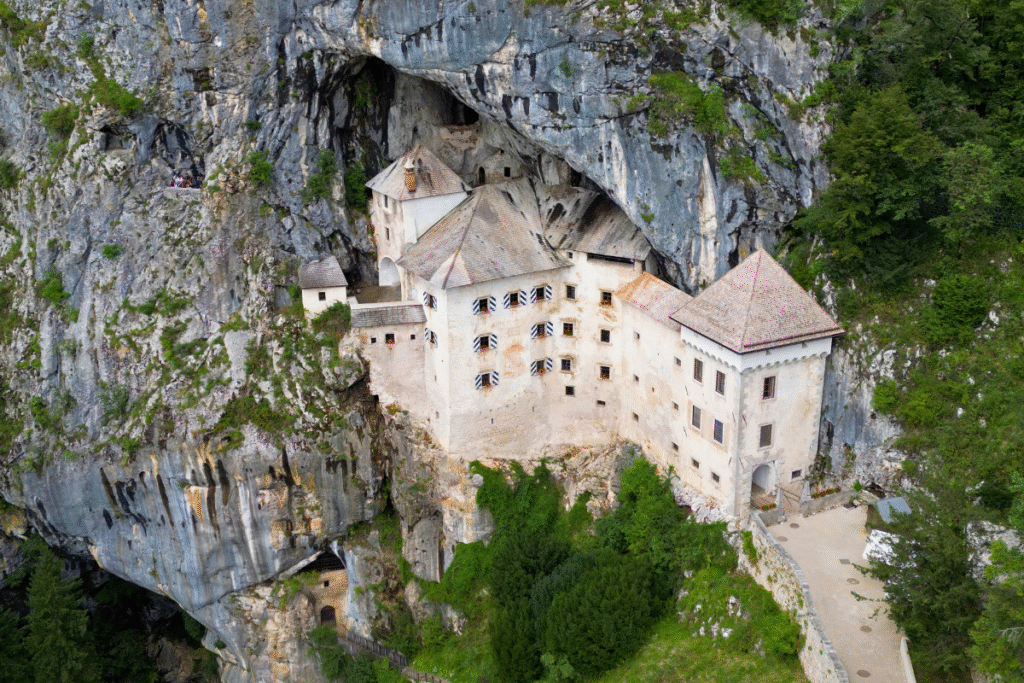
Predjama Castle is different from any other castle you’ll see in Europe. Built right into the side of a sheer cliff, it almost looks like a secret hideout. The walls seem to grow out of the rock, and there’s a huge cave beneath. For most travelers, it’s the setting alone that makes Predjama unforgettable.
What draws people here—besides the scenery—is the legend of Erazem Lueger. He was a rebellious knight who made this castle his refuge over 500 years ago. Thanks to a hidden tunnel leading through the cave, he held out against a siege for months. In the end, he was betrayed and killed inside the castle. Some say his story lingers in the darker corners. If you walk through the tunnels or pause in the colder rooms, you might sense it—a draft, an echo, or the feeling someone’s close by.
Predjama has been standing for more than eight centuries. Through that time, it’s been a fortress, a noble’s home, and even a hiding spot for thieves. Inside, you’ll find simple stone rooms, narrow staircases, and old wooden doors. The displays tell stories about medieval life, local legends, and the castle’s many uses over the years.
What makes your visit special here is how much the building blends with the cave. It’s cool inside, even in July. There’s always the sound of water dripping somewhere in the background. The valley outside feels peaceful, but inside, you get a sense of shelter and secrecy. Climb up to the ramparts for wide views or explore the lower passages for a real adventure.
Travel Tips:
- Best Time to Visit: The castle is open all year, but the cave tours run from May to September. Go in late spring or early fall for quieter paths and good weather.
- Tickets & Tours: Buy tickets at the entrance or online. There’s a combined ticket with the nearby Postojna Cave, which is popular. Guided tours give extra details and help you find the castle’s secret spots. Check the official website for the latest ticket prices and up-to-date opening hours.
- Accessibility: There are lots of steps, and the pathways are uneven. Not all areas can be accessed with a stroller or wheelchair.
- Extras: The cave system under the castle is a highlight—don’t skip it if you’re curious about underground spaces.
- Pro Tip: Dress in layers and wear solid shoes. It’s always cooler and a bit damp inside, no matter the season.
- Website: https://www.postojnska-jama.eu/en/predjama-castle/
If you want to see a castle where history, legend, and nature come together, Predjama is the spot. Give yourself time to explore—this place is full of surprises.

Houska Castle, Czech Republic: The Gateway to Hell

Houska Castle sits deep in the forests north of Prague, away from any main roads or busy towns. What makes this place stand out isn’t its size or beauty, but its reputation as one of Europe’s strangest—and most unsettling—castles. Locals have called it the “gateway to hell” for centuries, and a visit here feels different from any other castle on this list.
Most of the stories start with the chapel built right over a deep, natural hole in the ground. Long ago, people believed this pit was so deep that it led directly to the underworld. The original builders covered it, hoping to trap whatever evil might climb out. Over the years, there have been rumors of half-human creatures, ghostly figures, and unexplained noises from below the floor. Some visitors say they still feel uneasy in the chapel or hear odd sounds echoing through the halls.
Houska was built in the 13th century, not for defense or show, but to seal off that mysterious hole. Unlike other castles, it has very few defensive features and faces inward, as if trying to keep something inside rather than protect from outside threats. Over time, it served as a manor, hunting lodge, and even a Nazi base during World War II. Each chapter in its history adds another layer to its odd, haunted reputation.
What you’ll notice most at Houska is the quiet. The thick woods around the castle make it feel hidden from the world. Inside, the rooms are cool and a bit dark, and the windows look out onto nothing but trees. The murals in the chapel—showing strange creatures and battles—only add to the sense that this is a place built to keep secrets.
Travel Tips:
- Best Time to Visit: Houska Castle is open from spring through autumn. Late spring and early fall have the best light and fewer crowds.
- Tickets & Tours: Tickets are sold on-site, with guided tours available in Czech and English. It’s a good idea to check the official website before visiting for opening times and special events.
- Accessibility: Some stairs and uneven floors, so comfortable shoes are important. Not all areas are accessible for those with limited mobility.
- Extras: Look for the old murals in the chapel—they’re unusual and worth a closer look.
- Pro Tip: Spend a moment alone in the chapel or courtyard. It’s often the quietest spots that feel the strangest.
- Website: https://www.hrad-houska.cz/en/
Houska Castle isn’t just a stop for ghost hunters—it’s a place for anyone who likes mysteries, legends, and places that make you question what’s real. If you want a castle visit that feels truly different, put this one on your list.

Dragsholm Castle, Denmark: Ghosts in the Manor
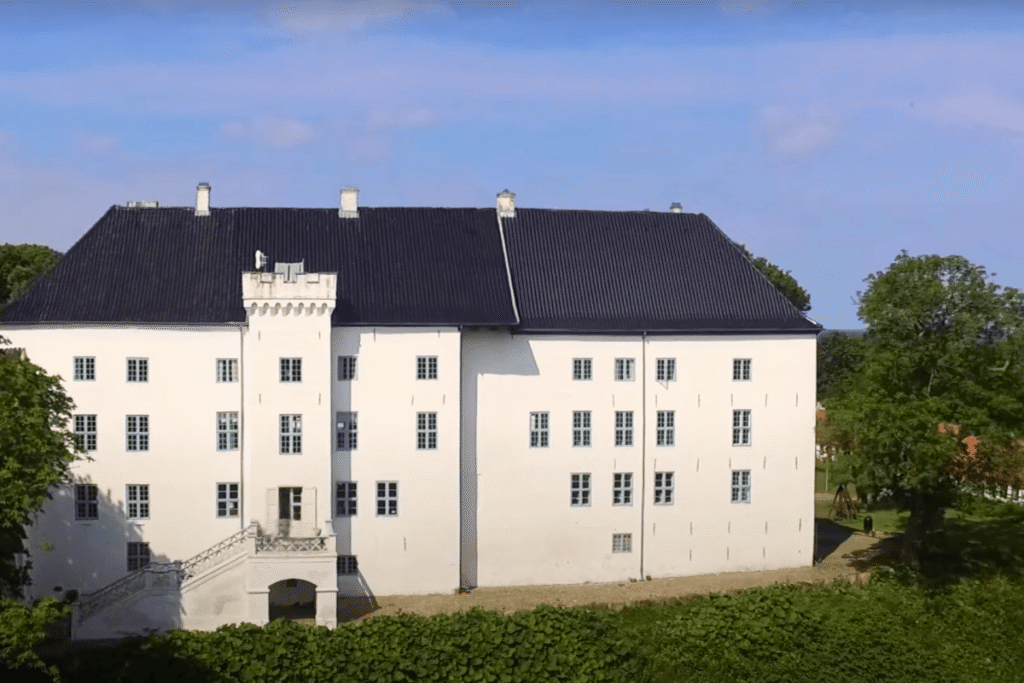
Dragsholm Castle is an easy day trip from Copenhagen, set in the middle of open countryside with wide views and a quiet moat. If you’re after a spot that mixes comfort, real history, and a dash of the supernatural, this place deserves a spot on your list.
This castle is famous for three main ghost stories. The White Lady is at the top—said to be the spirit of a young woman bricked up by her own family for loving the wrong man. The Grey Lady, thought to be a kind servant, is said to check in on guests even today. Then there’s the Earl of Bothwell, a Scottish nobleman who died here as a prisoner. Some visitors hear strange noises or catch a chill in certain halls, while others say their rooms felt especially still at night.
Dragsholm is old—it was built in the 1200s and has seen everything from royal banquets to sieges and long stretches as a prison. The castle has changed with the times, but you can still find thick stone walls and original dungeons alongside comfortable hotel rooms and a modern restaurant. Even if you don’t meet a ghost, you’ll get a strong sense of the past.
What’s different here is how much you can experience in one place. You can tour the old jail cells, have dinner in a vaulted dining room, and spend the night in a room that’s seen centuries of stories. The gardens are quiet, good for a walk, and a nice break from the tales inside.
Travel Tips:
- Best Time to Visit: Dragsholm is open year-round. If you enjoy ghost stories, check their calendar for special events in autumn and around Halloween.
- Tickets & Tours: Day visitors are welcome to tour the castle, gardens, and dungeons. Book a ghost tour if you’re interested in the legends, or stay overnight for the full experience. Check the official website for all booking information.
- Accessibility: Newer sections are accessible, but some older areas have steps or uneven floors. Contact the hotel if you have specific needs.
- Extras: Don’t skip the restaurant—meals feature local produce and sometimes herbs from the castle’s own grounds.
- Pro Tip: Staff here often have their own stories. Ask politely, and they might share a ghost sighting or a bit of local history.
- Website: https://www.dragsholm-slot.dk/en/
Whether you’re looking for a unique hotel, a slice of Danish history, or a place with stories that stick with you, Dragsholm Castle is worth a visit.

Edinburgh Castle, Scotland: Spirits on the Rock

Edinburgh Castle is hard to miss. Sitting high on a rocky hill in the heart of Scotland’s capital, it’s one of the city’s best-known sights—and one of its most storied. As part of the UNESCO World Heritage-listed Old and New Towns of Edinburgh, this castle is a true icon. If you’re interested in history, ghost tales, or just want unbeatable views, this castle should be near the top of your list.
Ghost stories here come in all shapes. The most famous is the headless drummer boy, first reported during a siege centuries ago. Visitors and staff have also spoken about a phantom piper who vanished in the tunnels below, with his faint music sometimes drifting up on misty days. Cold spots, odd footsteps, and flashes of movement in the dungeons are common reports. Even if you come as a skeptic, you might find yourself glancing over your shoulder in the quieter rooms.
Edinburgh Castle’s past is packed with drama. It’s watched over the city for more than 900 years, serving as a royal residence, fortress, prison, and military base. Kings and queens were crowned here. The Crown Jewels of Scotland are still on display. There are also darker chapters, like the prisoners of war who were kept in its vaults, and public executions that once drew crowds.
What makes Edinburgh Castle different is how it feels once you’re inside. The thick stone walls hold a steady chill, and the wind off the North Sea sweeps through even in summer. Views stretch out across the rooftops and down the Royal Mile, but some of the best moments are found in quiet corners: a silent chapel, a shadowed staircase, or the dungeons below the Great Hall.
Planning a visit or want a deeper dive into Edinburgh’s most iconic castle? Find practical tips and hidden highlights in our Edinburgh Castle Guide.
Travel Tips:
- Best Time to Visit: Open year-round, but it’s busiest in summer. Autumn and winter visits are quieter and feel even more atmospheric.
- Tickets & Tours: Book your tickets online to save time—lines can be long. Guided tours and audio guides are both good options for hearing the legends and history. Check the official website for the most up-to-date ticket prices and schedules.
- Accessibility: The site is steep and has cobblestone paths. There are step-free routes, but some areas require climbing. Wear comfortable shoes.
- Extras: Don’t miss the One O’Clock Gun (fired daily) and the Crown Jewels exhibition.
- Pro Tip: For photos with fewer people, try to be among the first visitors in the morning.
- Website: https://www.edinburghcastle.scot/
Whether you’re chasing ghosts, exploring Scotland’s past, or just enjoying the view, Edinburgh Castle is a place where history and legend sit side by side. Take your time—there’s plenty to discover around every corner.

Eltz Castle, Germany: The Enchanted Outpost

Eltz Castle is the kind of place that makes you stop and stare. Tucked into a forested valley above the Moselle, it isn’t visible until you’re almost there. The walk down is quiet, surrounded by tall trees, and then suddenly the towers rise up out of nowhere—a genuine surprise for first-time visitors.
While Eltz doesn’t market itself on ghost stories, local legend says Countess Agnes, who died defending her home, still keeps watch. Some people say they’ve heard footsteps in empty rooms or felt a sudden chill, especially in the older parts of the castle. Most visitors, though, are drawn by the feeling of stepping into another time. If you like places where the past feels close, you’ll enjoy wandering these halls.
The Eltz family has owned this castle for more than 850 years, and it’s one of the few German castles never destroyed by war. That means you get to see original architecture, period rooms, and collections of weapons, coins, and paintings. Each part of the tour brings new details—colorful heraldry, narrow staircases, and views of the valley below.
Eltz stands apart for its setting. It’s surrounded on all sides by thick woods and a winding river. Autumn is especially beautiful, with the hills turning gold and red. The courtyard is usually busy, but it’s easy to find quieter corners or step out for a walk along the riverbank.
For a deeper look at Eltz’s stories, highlights, and everything you need to plan your trip, visit our Eltz Castle Guide.
Travel Tips:
- Best Time to Visit: Open April to early November. Early autumn offers fewer crowds and colorful scenery. Weekdays and early mornings are the quietest.
- Tickets & Tours: Buy your ticket at the entrance. Guided tours are included, and the guides share both family history and local stories. Check the official website for up-to-date opening times and ticket prices information.
- Accessibility: The road to the castle is steep. Shuttle buses are available for those who need them. Inside, expect old stairs and uneven floors, so wear good shoes.
- Extras: Take time to explore the treasury—there’s a lot to see, from jewels to medieval armor.
- Pro Tip: The hike to the castle is part of the experience. If you can, skip the shuttle at least one way for better photos and a sense of the landscape.
- Website: https://burg-eltz.de/en/
Eltz Castle isn’t just a photo stop; it’s a rare place where you can get close to centuries of real family history, surrounded by one of Germany’s prettiest landscapes. Give yourself a few hours—you won’t regret it.

Burg Frankenstein, Germany: The Original Monster’s Castle
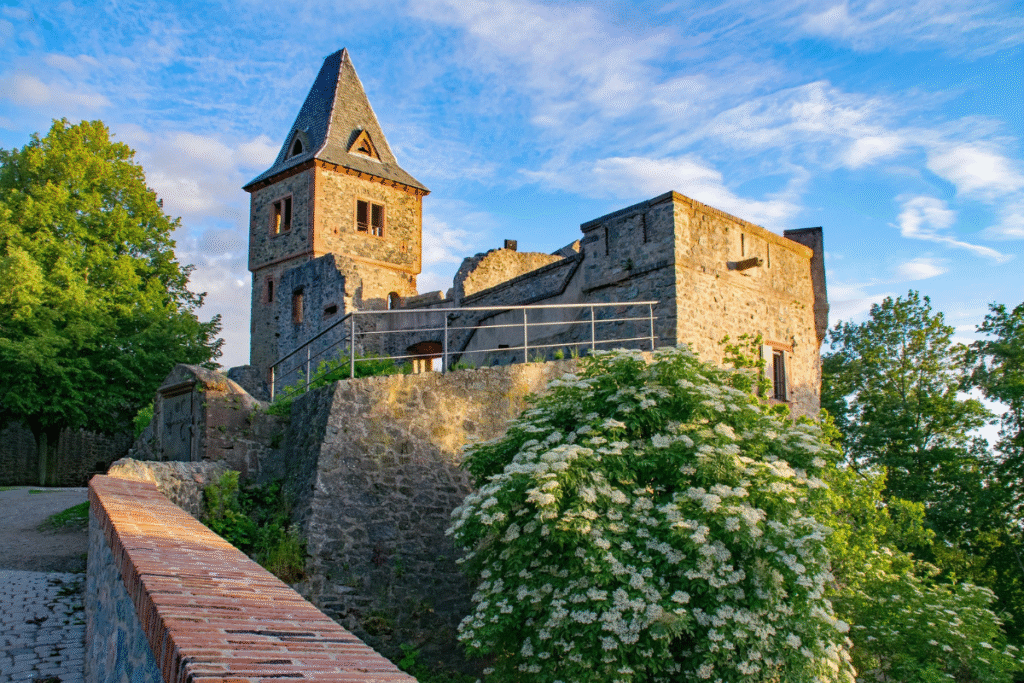
Burg Frankenstein sits on a wooded hill near Darmstadt, about a 40-minute drive from Frankfurt. The site is easy to reach by car, and you’ll spot the old towers rising above the trees as you approach. The place feels a bit wild—part ruin, part restored castle—making it a different experience from the polished palaces elsewhere in Germany.
The big draw here is the link to Frankenstein’s monster. The story goes that Johann Conrad Dippel, who practiced alchemy at the castle in the 1700s, helped inspire Mary Shelley’s famous novel. Whether or not that’s true, Burg Frankenstein has earned its reputation as a spot full of legends. The most talked-about ghost is Anna von Frankenstein, who, according to local tales, fell from the tower. Some visitors say the chapel or the darker corners feel heavy, especially as dusk approaches.
The castle has medieval roots and a lot of history as a fortress, but much of what you see now is open ruin. There’s plenty to explore on your own—walk the walls, climb the tower for a sweeping view, or wander the wooded trails around the site. The atmosphere is most intense in late October, when the famous Halloween festival transforms the grounds with haunted houses, live shows, and big crowds. The rest of the year, you’ll likely find it quiet and uncrowded.
Travel Tips:
- Best Time to Visit: Open all year. October is for Halloween fans, but if you want the ruins to yourself, visit midweek any other month.
- Tickets & Tours: Entrance is usually free except during Halloween events, which require advance tickets. The festival gets busy and often sells out early. Frankenstein Castle is currently being renovated until the end of 2028. Therefore, it can be closed from time to time. Check the official website for the most up-to-date information about opening times.
- Accessibility: The ground is uneven and there are steps and gravel. Good walking shoes are a must, especially after rain.
- Extras: There’s a restaurant with local food right on site. Check the event calendar—occasional medieval fairs or music nights are worth a look.
- Pro Tip: Bring a flashlight if you’re staying into the evening—the grounds have very little lighting after sunset.
- Website: https://www.schloesser-hessen.de/en/burg-frankenstein
If you want a castle visit that’s heavy on atmosphere, low on crowds, and full of stories, Burg Frankenstein is well worth the stop. Come for the legend, the festival, or just to watch the sun go down from the old walls.

Voergaard Castle, Denmark: Shadows on the Moat
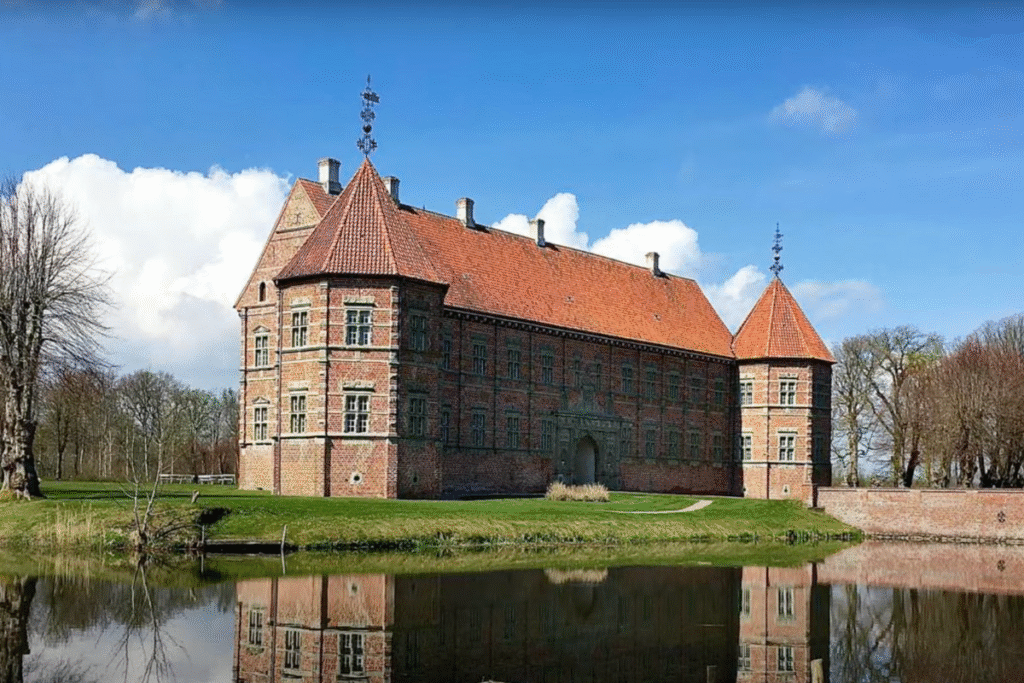
Voergaard Castle sits in the countryside north of Aalborg. Surrounded by a wide moat and open fields, it’s easy to reach by car and stands out for its bright red brick and tall towers. While it’s known for its Renaissance art and architecture, many visitors come for the ghost stories that have stuck with the castle for generations.
The most famous legend is about Ingeborg Skeel, a powerful noblewoman from the 1500s. Some people say her ghost still moves through the halls, especially in the evenings. Staff have talked about cold drafts, odd sounds, or glimpses of someone moving on the upper floors when no one else is there. There’s also a local tale about a builder who met a bad end here—supposedly, he hasn’t quite left either.
Voergaard has a long history. Built in the 16th century, it has survived wars and passed through many families. Today, it’s a mix of museum and private home. Guided tours will show you rooms filled with antiques, rare art, and even some pieces that once belonged to French royalty.
What sets this castle apart is the quiet, especially in the late afternoon. The grounds are green and peaceful, and when the sun starts to set, the water around the castle reflects everything in gold. If you like art, history, and a little mystery, this is a solid choice.
Travel Tips:
- Best Time to Visit: Voergaard is open mainly in the summer months. Check the official site for opening days, tour times, and any special events.
- Tickets & Tours: Guided tours are the best way to see inside—English tours are sometimes available, especially during festivals or art shows. Check the official website for up-to-date opening times and ticket prices information.
- Accessibility: Most rooms are reachable, but there are stairs and uneven floors. Good walking shoes will help.
- Extras: Look for special exhibitions or food events—these make a visit even more interesting.
- Pro Tip: Ask your tour guide if they’ve ever experienced anything odd themselves. You’ll often get a personal story or two.
- Website: https://www.voergaard.dk/
Voergaard Castle isn’t crowded or flashy, but it offers a real sense of the past, a strong art collection, and a few good chills if you like a ghost story. Give yourself enough time to wander the grounds and soak in the atmosphere.

Ballygally Castle, Northern Ireland: A Coastal Haunt

Ballygally Castle is right on the edge of the sea, about 40 minutes north of Belfast along the Causeway Coastal Route. You can’t miss its turreted towers and thick stone walls as you drive into town. Today it’s a hotel, but it still feels old—more charming than spooky, with views of the water and a strong sense of local history.
The castle’s best-known story is that of Lady Isobel Shaw. Local legend says her husband locked her in a tower room, and she either jumped or fell trying to escape. Over the years, guests have reported unexplained knocks at the door, cool breezes in empty hallways, and the faint smell of flowers. Some say they’ve glimpsed a woman in a long dress near the tower room. The atmosphere here isn’t scary—just a little mysterious and inviting for anyone who likes a good story.
Ballygally Castle was built in 1625 and has stood through centuries of storms, sieges, and changes in ownership. The building mixes old stone with modern updates, so you get original features like thick doors and narrow windows alongside comfortable hotel rooms. The “Ghost Room” in the tower is open for curious visitors, even if you’re not staying the night.
What’s special about Ballygally is the mix of old and new. You can stroll the beach, relax in the gardens, or enjoy afternoon tea in the lounge. Even if you’re not into ghosts, the coastal setting and friendly service make it a great place to stop.
Travel Tips:
- Best Time to Visit: The hotel is open year-round. Visit in spring or autumn if you want quieter beaches and dramatic skies.
- Tickets & Tours: Anyone can ask to see the old parts of the castle and the Ghost Room. Just check at the front desk. Check the official website for all booking information.
- Accessibility: Most areas are accessible, but some of the oldest stairways are narrow and steep. If you need step-free access, call ahead to plan your visit.
- Extras: The hotel restaurant is known for its afternoon tea—book a table with a view if you can.
- Pro Tip: Staff are happy to share ghost stories or tips for exploring the area. Don’t be shy about asking questions.
- Website: https://www.ballygallycastlehotel.com/
Ballygally Castle is perfect if you want a comfortable place with real history, a touch of mystery, and some of the best coastal scenery in Northern Ireland. Give yourself time to enjoy both the stories and the view.

Pidhirtsi Castle, Ukraine: The Forgotten Palace
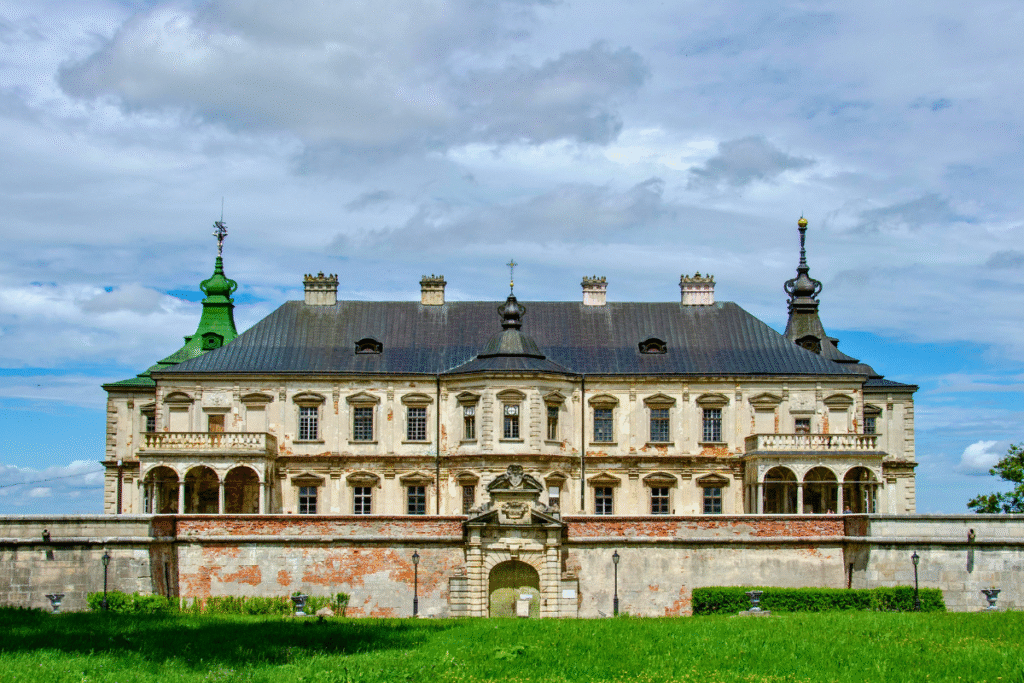
Pidhirtsi Castle stands at the edge of a quiet village about an hour and a half east of Lviv. The building is huge—more palace than fortress—with wide terraces and stone balustrades that overlook open fields. These days, much of the castle is worn and weathered, but the faded grandeur makes it all the more atmospheric.
Local legend centers on the “White Lady,” a noblewoman said to haunt the halls after a tragic death centuries ago. People have reported cold spots, the sound of footsteps when no one’s there, and the occasional glimpse of a pale figure on the upper floors. Even if you don’t believe in ghosts, the empty corridors and peeling walls give the place an eerie, unforgettable feel.
The castle dates back to the 17th century and was once one of the grandest homes in Eastern Europe. It hosted balls, military meetings, and visiting royalty. After wars, fire, and Soviet occupation, many rooms are now empty or awaiting restoration. A tour shows you both the beautiful details—like stone carvings and murals—and the damage of the past hundred years.
What stands out at Pidhirtsi is the quiet. You can walk through big, echoing rooms and step into overgrown gardens where weeds have taken over the paths. The view from the terrace goes for miles over farmland. It’s easy to imagine what this place was like at its height—and how different it feels today.
Travel Tips:
- Best Time to Visit: Spring and early fall are best for mild weather and clear views. Avoid visiting right after heavy rain, as some roads can be muddy.
- Tickets & Tours: Guided tours are usually available on weekends and holidays. Double-check schedules in advance and book if possible. Check the official website for all visiting information.
- Accessibility: Most of the site is uneven. Sturdy shoes are needed, and parts may not be accessible for visitors with mobility issues.
- Extras: Bring a flashlight for darker rooms and plenty of memory for your camera—the light at sunset is especially good.
- Pro Tip: It’s easiest to reach the castle by car or as part of a tour from Lviv. Local guides can help with stories and translation.
- Website: https://lvivgallery.org.ua/museums/muzey-zapovidnyk-pidgoreckyy-zamok
Pidhirtsi Castle is ideal for travelers who enjoy places off the main tourist path. Give yourself time to walk, listen, and imagine what the empty halls have seen. The stories are just part of what makes this spot special.

Montebello Castle, Switzerland: The Blue-Blooded Mystery

Montebello Castle sits just above the center of Bellinzona in southern Switzerland. Recognized as part of a UNESCO World Heritage Site along with Bellinzona’s other famous castles, Montebello is easy to reach on foot from the old town—just a short uphill walk or a quick drive if you have a car. The castle itself is solid, with thick stone walls and towers, and you’ll get wide views over the city, the valley, and the mountains beyond.
One of the main reasons people talk about Montebello is the story of the White Lady, said to be the spirit of Bianca Maria. She was a young noblewoman whose life ended in tragedy, and some believe she still wanders the halls. Visitors sometimes mention cold spots or a glimpse of a white figure in quiet corners. Whether you believe the tales or not, there’s something memorable about exploring the rooms and walking the ramparts with centuries of history behind you.
Montebello was built in the 13th century, expanded by later rulers, and today is one of Bellinzona’s three castles recognized by UNESCO. Inside you’ll find a small museum with old weapons, armor, and everyday objects from the region’s past. The displays are simple, and most signs are in several languages. You can climb the towers, walk along the walls, and get a good sense of how the castle was used in different eras.
What stands out here is how much is open to explore. The castle grounds are spacious, and there’s room to wander, picnic, or just take in the views. Late in the day, the light makes the stone glow, and the town below looks especially pretty.
Travel Tips:
- Best Time to Visit: Open from spring through fall. Late spring and early autumn bring mild weather and fewer visitors.
- Tickets & Tours: You can buy a ticket just for Montebello or get a combined ticket for all three Bellinzona castles. Guided tours are sometimes available—ask at the desk or check the website before your visit. Check the official website for up-to-date opening times and ticket price information.
- Accessibility: Paths around the castle are mostly easy, but the towers have steep stairs and narrow steps. Good shoes make a difference.
- Extras: Check the calendar for special exhibits or festivals—these can add a lot to your visit.
- Pro Tip: Bring a picnic or snacks. There’s plenty of space on the grounds to sit and enjoy the view, especially in good weather.
- Website: https://fortezzabellinzona.ch/en/discover-montebello/
Montebello Castle is great for travelers who want real history, big views, and the chance to step off the main tourist path. Give yourself time to explore, and make sure to see the other two castles in Bellinzona if you can.

Château de Brissac, France: The Green Lady’s Watch
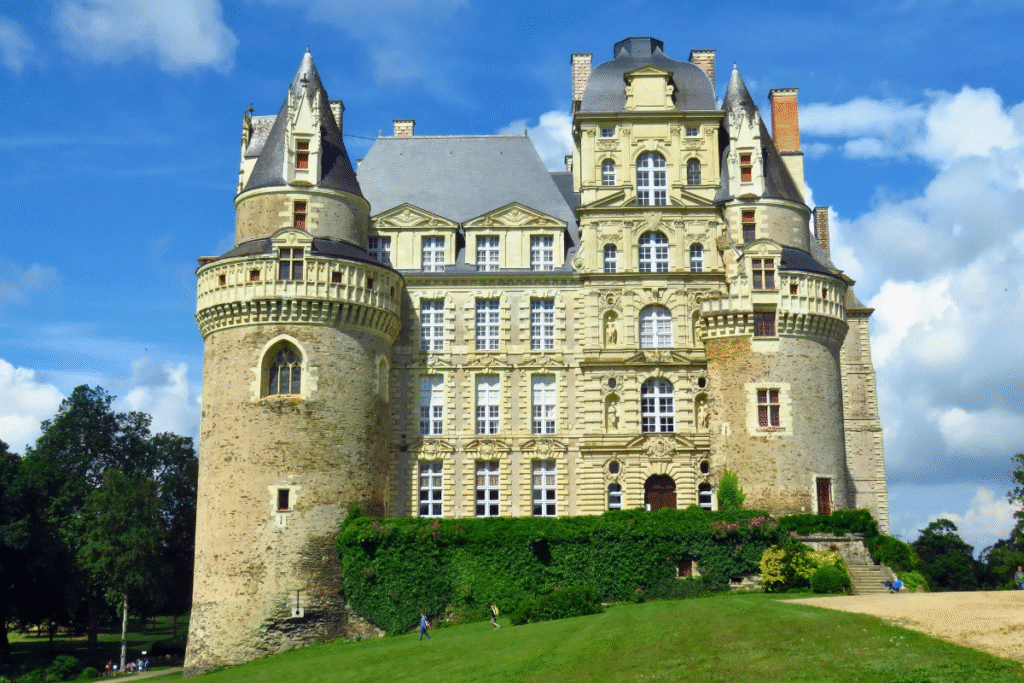
Château de Brissac rises above its parklands in the Loire Valley, about 15 kilometers south of Angers. This isn’t just another Loire château—it’s the tallest in France, with seven stories, hundreds of rooms, and a blend of old stone towers and grand Renaissance halls. The drive up to the gates is impressive, and the first view of the building makes most visitors stop for a photo.
The castle is well known for the story of the Green Lady, said to be the ghost of Charlotte of France. Local legend claims she was murdered in the castle in the 15th century and still appears to guests, dressed in green. People sometimes mention hearing soft crying, or catching a glimpse of a woman in old-fashioned clothes near the chapel or one of the older staircases. The atmosphere isn’t frightening—if anything, it just adds a sense of mystery to the tour.
Brissac has been lived in for nearly a thousand years. The same family still owns it, and parts of the house are private, but you can tour most of the major rooms. These include elegant salons, bedrooms lined with portraits, and a small theater. Outside, the grounds offer quiet walks, a lake, and places to sit in the shade.
What makes Brissac stand out is that it feels lived-in and lively. There are regular tours, tastings of wine made from the estate’s own vines, and sometimes concerts or art exhibitions. You get more than just old stones—you get a sense of family history and daily life.
Travel Tips:
- Best Time to Visit: Open most days from spring through autumn. May and June bring good weather and blooming gardens. Harvest season in September is also popular for wine lovers.
- Tickets & Tours: Admission includes a guided tour, usually in French, with printed guides in other languages. Tours run at set times—check the official website or call ahead if you need details in English.
- Accessibility: Main rooms are accessible, but older sections have steep steps and uneven floors. Sturdy shoes help.
- Extras: The château makes its own wine, and tastings are available in the cellar shop.
- Pro Tip: Leave time for a walk in the park, and ask about any special events or temporary exhibits.
- Website: https://brissac.net/en/the-castle/
If you want a castle that’s still alive with activity—and you’re curious about both legends and local traditions—Brissac is a great choice. Take your time here; there’s more to see than just the architecture.

Travel Planning: Making the Most of Europe’s Haunted Castles
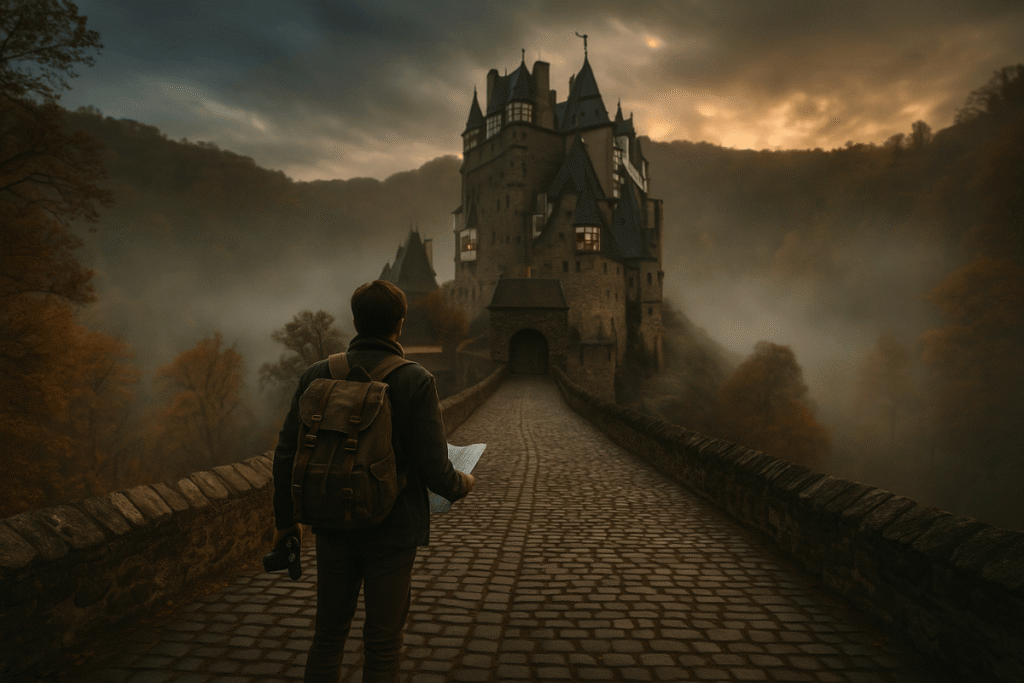
If you’re thinking about exploring haunted castles across Europe, a bit of practical planning goes a long way. No two sites are alike—some are polished and lively, others feel remote and half-forgotten. Here’s what I’ve learned from years of castle chasing, with a few stories to help you avoid my rookie mistakes:
Choose Variety—You’ll Thank Yourself:
Mix up your plans. Spend one night in a castle hotel (Ballygally was a favorite—I woke up to sea fog and fresh scones) and set aside time for wandering atmospheric ruins like Burg Frankenstein, where my shoes collected more mud than I care to admit. The contrast keeps things fresh and gives you different kinds of memories.
Check Times, Tickets, and Weather:
Before heading out, always double-check each castle’s website. Hours and ticketing rules change with the seasons. I once arrived at Voergaard Castle on a Monday, only to find it closed for a private event—my own fault for not looking ahead. Some castles, especially those hosting Halloween tours, sell out weeks in advance. Book early if you’re keen.
Go Early, Stay Late:
If you want space to explore, try to arrive as soon as the gates open or stick around until near closing. At Eltz Castle, I had nearly the whole courtyard to myself just before sunset, and the mood was completely different without the daytime crowds. Many staff are also more relaxed and chatty at these times—they often have the best ghost stories.
Dress for the Experience:
Castles are rarely designed with comfort in mind. There will be stairs, stone floors, and maybe a draft or two. I learned the hard way at Leap Castle that thin sneakers and damp Irish mornings don’t mix—bring shoes you trust and layers you can add or shed as the weather changes. Some interiors are colder than you’d expect, even in summer.
Be Curious, But Respectful:
Guides love a good question—ask them if they’ve ever experienced anything strange. I’ve heard stories from castle staff that never show up in brochures. But remember, some castles double as family homes. Respect private signs and always ask before snapping photos in private rooms.
Pack Light, Pack Smart:
A small flashlight can help in dim corridors or evening tours. A power bank is great for photos. If you keep a journal, jot down names and stories while they’re fresh—details blur fast after a long day.
Embrace the Surroundings:
Many castles sit near great walking trails, quiet villages, or local bakeries. After my tour at Château de Brissac, I stumbled into a farmers’ market in the next village and ended up chatting with a cheese maker about haunted houses (her verdict: “ghosts are fine, as long as they’re quiet”). Don’t rush off—these side trips are sometimes the best part of the day.
Take a Piece of the Story With You:
If there’s a gift shop, you’ll usually find local crafts, food, or books. They make thoughtful souvenirs and support restoration projects.
Above all, stay open to the experience. Haunted castles have a way of surprising you—sometimes with a story, sometimes with a sudden chill, and sometimes with a perfect moment of quiet you didn’t expect. Every visit is different. Go with curiosity, and you’ll walk away with stories worth telling.

Final Thoughts
Europe’s haunted castles are more than just beautiful backdrops—they’re living reminders of how history, legend, and daily life overlap in unexpected ways. After years of wandering through drafty halls and shadowy staircases, I’ve realized these places are never just about ghosts or grand architecture. They’re about the feeling you get when you pause and listen—maybe it’s the wind in an empty courtyard, or a guide sharing a story that isn’t written anywhere.
The most memorable moments for me haven’t come from a planned tour or a famous legend. Once, in the gardens at Dragsholm, I got completely turned around and ended up chatting with a gardener who swore he’d seen the Grey Lady early one morning. At Leap Castle, a fellow traveler handed me a flashlight and dared me to poke my head into the Bloody Chapel alone—I won’t pretend I wasn’t nervous.
If you set out to visit these castles, keep your plans loose and your eyes open. Let the place surprise you—sometimes it’s the quietest room, a cool spot in the sun, or even a conversation with another curious traveler that stays with you. Don’t worry about “seeing everything.” Sometimes, just standing still for a few minutes gives you more than a dozen photos.
💬 Have you walked into a room and felt the hairs on your neck stand up? Did you hear a story from a local that stuck with you? Share your favorite haunted castle moments in the comments below—I’d love to hear about them, and other readers will too.
👻 If you’ve captured your own ghostly shot or discovered a hidden corner, tag @CastleQuestChronicles on Instagram so we can share in the adventure. There’s always another story waiting inside these old walls, and your voice is part of what keeps them alive.
👉 And if you’re still hungry for more castles, take a look at these next:
- 10 Best Castles to Visit in Scotland: A Complete Travel Guide
- Bavaria Castle Road Trip: The Ultimate 7-Day Itinerary Through Germany’s Fairytale Heart
- The 25 Most Famous Castles in the World: Iconic Fortresses You Must See
Happy exploring, and remember: sometimes the best discoveries happen when you’re not looking for them.
📸 And if this article sparked your curiosity about the castles, follow along. We are on Instagram, Pinterest, Facebook, and X, too. More castles (and more stories) are just around the bend. Explore all our castle adventures here!

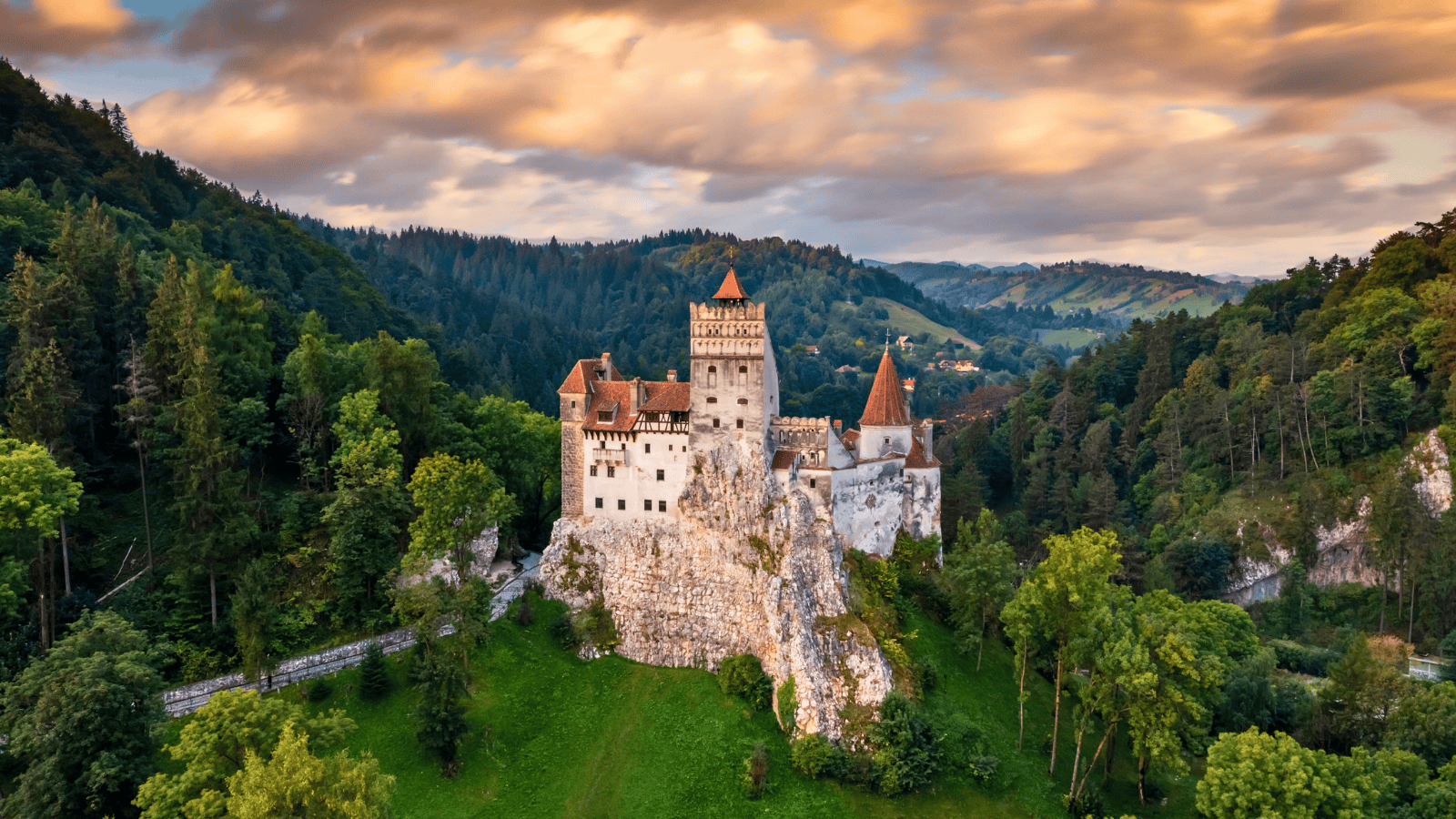
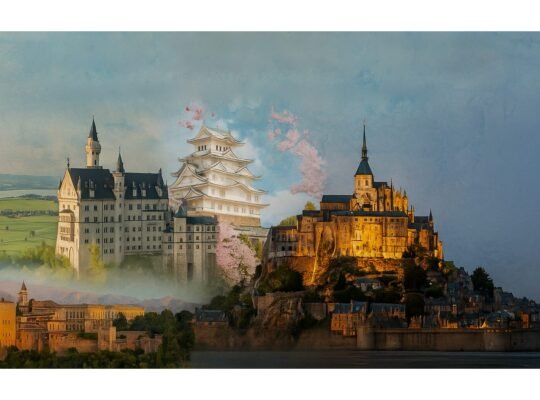


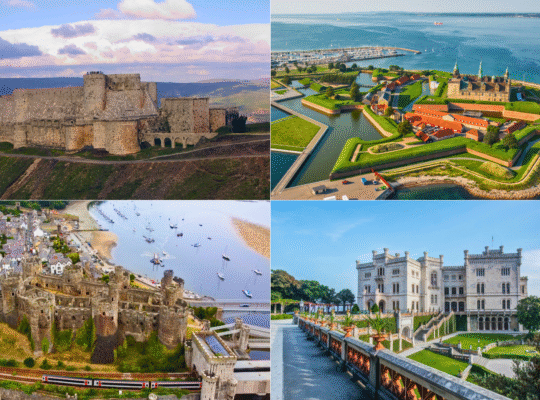


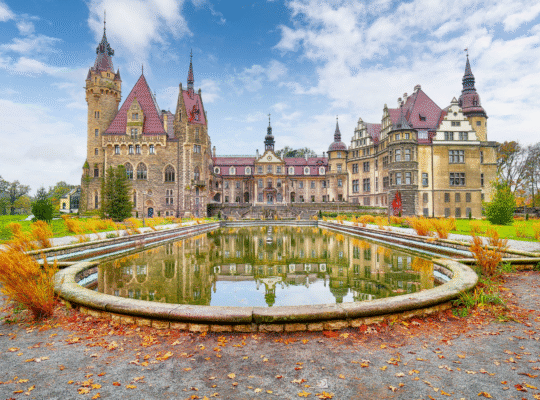


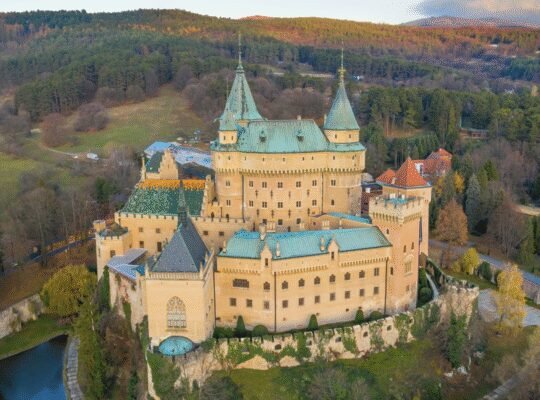
1 Comment